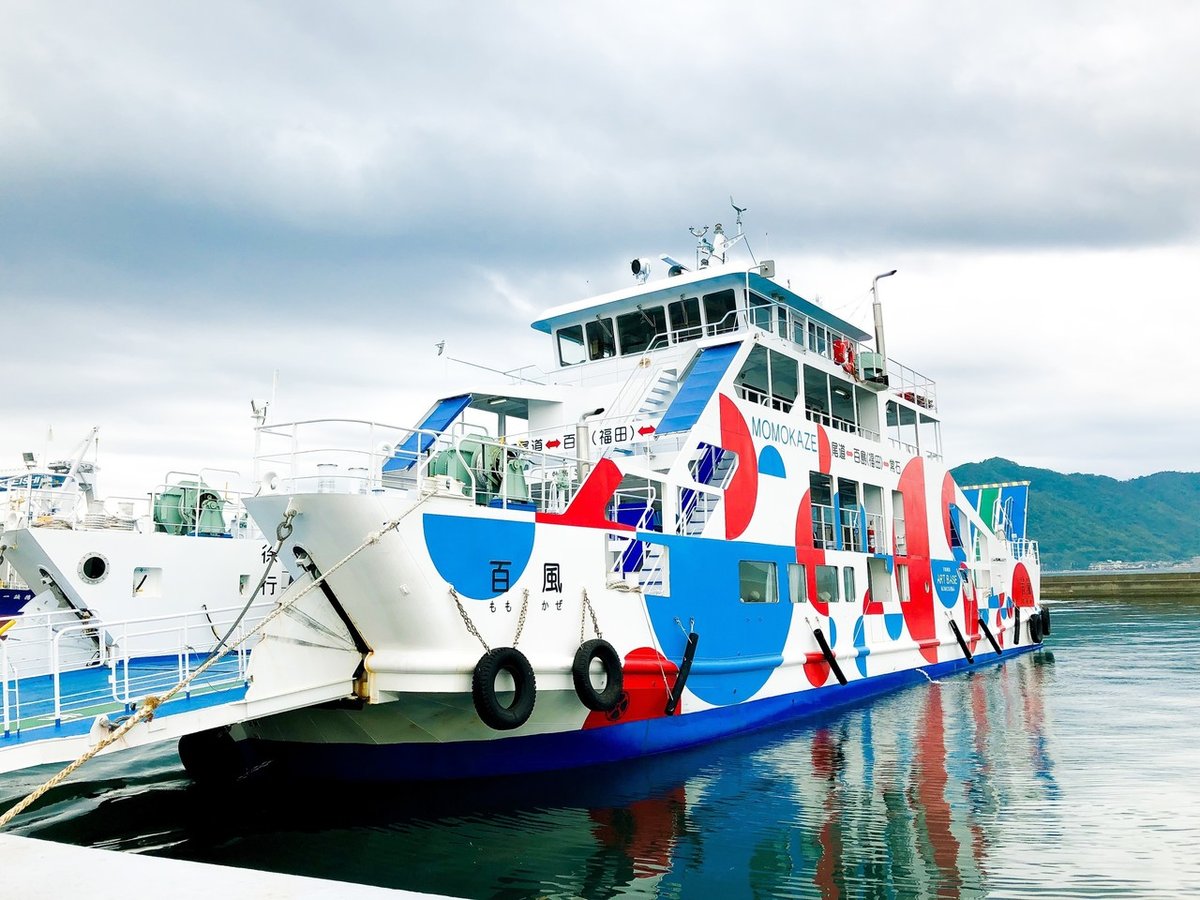
福山から渡る島【日帰りtrip 百島】 trip from Fukuyama
手元の地図を少し遠ざけて眺めると、福山が面する瀬戸内海には無数の島がある。小豆島、豊島、直島、因島、生口島……。耳にしたことがある名前の島を見つけてみる。

福山から渡れそうな島はどれだろうかと、少し寄って見てみると、そこにはおそらく初めて聞く名前の島々がポツポツと浮かんでいる。
そのひとつには、百島と名前が付いている。「百島」と書いて、「ももしま」と読む。先の“聞いたことのある島”と比べると、少々こじんまりしている。諸説あるという名前の由来のひとつは、「その昔、桃の果樹が多く『桃島』と書かれていたものに、いつの頃からか『百』の字があてられるようになった」というものだ。

この島には何があり、どんな人がどんな暮らしをしているのだろうか。
伏見町からバスを乗り継いで常石港に向かえば、この百島に渡る船がある。“瀬戸内”と冠されて組まれた雑誌の特集にも出てこない島だけど、福山のすぐ近くにある島。その姿を知りたくて、衝動に任せて行ってみることにした。

常石港に到着すると、「フェリー百風(ももかぜ)」が迎えに来てくれた。ペイントが愛らしくて、なんだか嬉しい旅の始まりだ。

百風での船旅はたった10分。あっという間に島に降ろされた。

予定もない知り合いもいない私は、くねくねと続く道をただ追って歩いてみる。ぐるりと周っても約12kmしかないというこの島の現在の人口は474人。特にこんな雨のパラつく日にはなかなか人にも出会わない。

アップダウンのある道、小さな畑、小さなバス停、年季の入った家。伏見町を出てバスと船を使って1時間ちょっと。農業と漁業を続けてきた小さな島にあるまったく違う時間の流れと景色だ。

集落をぶらぶらしていると、「爺ちゃま倶楽部」という謎な看板を掲げた店がある。戸を開くのに、少し勇気の要る風貌の店だけど、「旅先だもの」、飛び込んでみる。
扉を開ける。鉄板を前に立っていたのはやっぱり爺ちゃんで、「そういうことね」と、ひとり納得しながら席に着く。
もともと和食の出張料理人として働いていたという爺ちゃんは、各地で飲食店の立ち上げや料理長を経験した後、定年を機にひとりで百島に移住したという。空き家を改装してオープンしたのが、このお店というわけだ。

なんと、この島にある飲食店はここだけだと言う。小さな島の飲食店は時代の流れと、島民の減少とともに少なくなった。そうとは知らずに店を見つけられた私に、「お前さんはついてるよ」と言う。メニューはなく、予算と食べたいものを伝えればなんでもつくってくれる。とりあえずお好み焼きとビールを注文した。
「この島に来るまで、いろんな店の料理長をやってね。でも、そろそろ体もいたわろうと、5年くらい前に、ゆっくり暮らすことを決めたんだ。この島には、食べるところも買い物するところもない。対岸にお弁当屋さんがあるけど、わざわざ船で持ってきてもらうなんてね。だったら、私の頭の中に詰まっている料理のすべてを、みなさんに振る舞えたらと思ってね」
お酒や食材の持込も自由。釣った魚を持ち込んで、「おっちゃん捌いて〜」というお客さんもいる。爺ちゃんはそれを料理する。それが、爺ちゃんが決めた、この島でのやり方だ。
この島には今、この飲食店がひとつ、島で初めてオープンしたパン屋、廃校を活用したアートスペース、それからカヌーや焼き物体験のアクティビティがあるという。
そしてこの日、店にやって来たのは、島でただひとり自然栽培に取り組むという西野さんだ。世界各国を旅していたという彼は、おばあさんが百島出身であったことから、結婚を機に移住してきたのだそう。奥さんとも旅先のインドで出会ったという筋金入りの旅人だ。西野家には長男が生まれ、子どもの少ない島では、血縁に関係なくたくさんのおじいちゃんおばあちゃんたちに我が孫のように可愛がられている。
「これから鶏を絞めるんですけど、一緒に来ますか?」 と、西野さん。鶏を絞めることに誘われたことなどないけれど、思い切って付いて行くことにした。

ふるさとのような場所になって欲しいという思いで名付けたという、西野さんの「百島ふるさと農園」。

自ら大工仕事をしてつくり上げたという。山から竹を取り、一本ずつ編んで、農園をぐるりと囲む柵をつくり、三角形の小屋もつくった。自然のなかにある美しい暮らしの造形だ。

鶏を絞め終えて連れられた畑は、いったいどこに畑があるのかと不思議に思う、ふさふさと草の生える景色だった。
「雑草だらけだけど、これが畑。種を蒔いただけで、水も農薬も一切与えない。でも、野菜も豆もちゃんと育つ。自然の力ってすごいから」
島のものが島で循環するようにと、週に一度の朝市も始めたら、毎週、島の人が我先にと駆けつけるようになったのだという。
夜、西野さんは、この日絞めた鶏をごちそうしてくれた。
この島では、人も食物も自分の力で生きている。穏やかでいて、強く根を張って。もっとこの島の人に出会ってみたい、暮らしを見てみたい、と後ろ髪を惹かれながら、港へと戻る。
ひと目見て、島の外からやって来たやつだと分かるのだろう。何人かの人に「なにしに来たん?」と声をかけられた。おっとりとした笑顔が嬉しかった。

伏見町からのショートトリップ。片道1時間ちょっとという少しの時間の向こうにあった、まったく違う旅の時間。また来よう。福山から少し足を伸ばしただけだけど、ディープな旅。福山から漕ぎ出して、そこにしかない暮らしの景色と、また会いに来たくなる人に出会える島はまだまだありそうだ。
【訪ねた場所】
●百島
百島Net
●爺ちゃま倶楽部
広島県尾道市百島町1336
現在予約制。希望の際は、前日の昼までにお電話を。(お爺ちゃまなので夜は電話に出られません)
080-4084-7146(佐野さん)
●百島ふるさと農園
広島県尾道市百島町3300‐1
050-5898-9627(西野さん)
nippichun@gmail.com
【百島へのアクセス】

① バス
福山駅前〜常石港(トモテツバス 瀬戸経由「常石」行 6番乗り場)
●所要時間:約43分
●乗車料金:720円
↓
② フェリーor高速船
常石港〜福田港(百島)
●所要時間:フェリーは約12分、高速船は10分
●乗船料金:250円
※切符売り場はないため、船内で購入
【駐車場】
●乗船桟橋手前の駐車場を利用できる。駐車スペースが狭いため、駐車できない場合があり。
【注意】
●常石港では自動車の乗降が可能。
●自動車の航送は歌港・常石港・福田港の3港間のみ可能。自転車はフェリーと高速船の両船で航送可能。
瀬戸内への旅の玄関口
福山駅前のまちやど「AREA INN FUSHIMICHO FUKUYAMA CASTLE SIDE」
●公式Webサイト
住所:伏見町4-33 FUJIMOTO BLDG. 1F(RECEPTION)
AREA INN FUSHIMICHOは、まち全体をひとつの「宿」と見立てた「まちやど」です。泊まる、食べる、くつろぐ、学ぶ、遊ぶ、さまざまな要素がまちのなかに散りばめられています。チェックインを済ませたら、伏見町、そして福山のまちから瀬戸内への旅へ。
この記事が気に入ったらサポートをしてみませんか?
